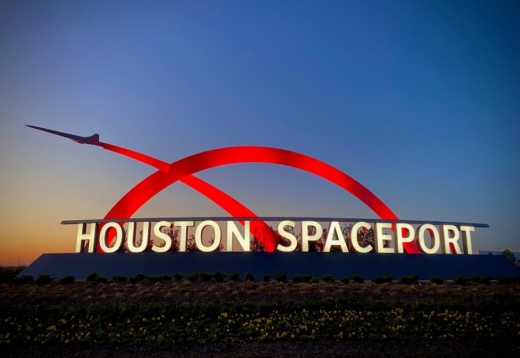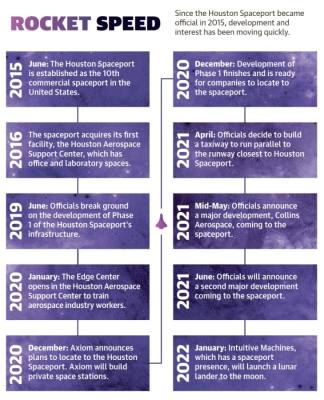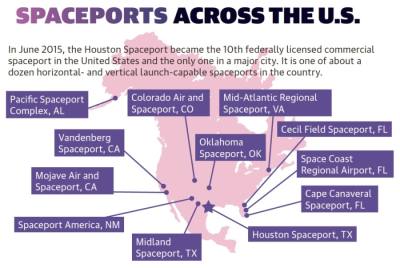Will “Houston” be the first word spoken by the first person to walk on Mars? This question has prompted Bay Area officials to act.
The Bay Area Houston Economic Partnership, which works to drive development in the Clear Lake area and beyond, has announced TexSpace, a new nonprofit that will work to make state leaders recognize Houston’s growing aerospace industry.
Meanwhile, the Houston Spaceport, located at Ellington Airport, now has infrastructure in place to allow for aerospace companies. Two such companies, Axiom Space and Collins Aerospace, are preparing to break ground, and a third development will be announced in June.
City leaders are excited by the progress the local aerospace industry has made in recent years, and they want that growth to continue to ramp up.
“[Our goal is] to be the global leader in space—home of the space economy,” said Bob Mitchell, president of the Bay Area Houston Economic Partnership. “We want to be all of it.”
Attracting national aerospace companies
TexSpace is the brainchild of Mitchell and astronaut Jack “2fish” Fischer, who now works as vice president of strategic programs at Intuitive Machines, a company building and testing a lunar lander at the spaceport that will go to the moon in January.
The idea is young and still forming, but the goal is for TexSpace to become a fully staffed nonprofit to help interested aerospace companies locate to Houston.
“The thought is we want to make the space industry Houston’s future, not just its past,” Fischer said.
Additionally, TexSpace would get state leaders to recognize and help Houston’s aerospace industry flourish.
“The idea is to wake up Texas—understand how important the space industry to the entire state of Texas,” Mitcaahell said.
BAHEP already exists to draw companies to the Bay Area. BAHEP helps connect interested companies with incentives to persuade them to locate to Clear Lake.
TexSpace will do the same but with an aerospace focus.
“There’s nobody doing that in a focused way in aerospace, and certainly not in Houston,” Fischer said. “That’s what TexSpace would do.”
Fischer said there are three important legs making up the triad of the future of aerospace locally, including government operations through NASA, commercial operations through private aerospace companies and a military presence. With all three located together, companies and aerospace leaders will excel, Fischer said.
“In Houston, we have to build a very strong bridge between three parts so we can all leverage each other to accelerate change and innovation,” he said. “TexSpace, whatever it evolves into—and it needs to evolve and grow—it will have several parts to it.”
TexSpace will also encourage aerospace companies to collaborate when possible, Mitchell said.
For instance, aerospace companies may need a thermal vacuum chamber or vibration table to test devices. These are expensive pieces of equipment that are not used often. Instead of every company buying this hardware for themselves, TexSpace would encourage companies to lease it to others, saving everyone money.
This move would also limit competition between local aerospace companies. Instead, officials would be able to concentrate on drawing companies to Clear Lake, Mitchell said.
“We don’t want the competition amongst ourselves. We want to compete against other states,” he said. “We gotta get everybody to play together.”
Aerospace companies do not need to be closely knit under the TexSpace umbrella. Intuitive Machines would not necessarily give their direct competitors an advantage, for instance, Fischer said.
“But we can all benefit by playing some part in this greater whole,” he said.
Charlie Stegemoeller works as senior director for business development for Science International Alliance Corp., one of the local aerospace companies TexSpace is targeting. Stegemoeller said he recognizes TexSpace’s value and agrees with its vision to make aerospace part of Houston’s future.
“Where do we want Houston to be 50 years from now?” he said, noting a strong aerospace industry should be among the city’s goals.
Stegemoeller agreed Clear Lake is the ideal place to set up a spaceport and an initiative such as TexSpace.
“One of the things to recognize is the Clear Lake area in Texas has all of the major players in aerospace in one location,” he said. “We’ve got skills that are much deeper than the rest of the world may know about.”
TexSpace’s development will take place in phases, but officials hope to move quickly.
“By the time we get to 2023, we want a powerful, globally recognized brand that anyone considering getting into the aerospace industry, the first place they stop ... is hopefully TexSpace,” Fischer said.
Spaceport growth
One major component in TexSpace’s vision is the Houston Spaceport.
Designated in 2015, the Houston Spaceport’s ultimate goal is to allow for commercial super- and hypersonic flights capable of delivering passengers to the other side of the globe in mere hours. Simultaneously, city leaders want the spaceport to be where aerospace companies locate to develop and test their hardware.
Phase 1, which broke ground in June 2019 and cost about $21 million of Houston Airport System funds, included contractors building streets, sidewalks, lights, power lines, water lines, fiber optic cables and more in about 154 acres of the spaceport.
“[Houston] City Council and Houston’s Mayor [Sylvester Turner] oversee HAS operations ... and have been supportive since day one when we proposed the spaceport development,” said Katherine Cunningham, deputy chief of staff for Mayor Pro Tem Dave Martin, who represents Clear Lake on Houston City Council.
The goal for Phase 1 was to build the infrastructure first to incentivize aerospace companies to locate to the shovel-ready spaceport, and it worked, Ellington Airport General Manager Arturo Machuca said.
“That foundation that was necessary to propel Houston into this new space economy, the foundation has been laid down,” he said.
Progress on the spaceport was slow at first, but with new infrastructure now in place, interest is booming, Mitchell said.
“When you actually build infrastructure, reality sets in, and now [progress] is off the charts,” he said.
In December, Axiom announced it will relocate its operations from California to the spaceport. The company plans to build private space stations that will hook into the International Space Station.
Earlier this spring, Venus Aerospace also announced it will locate to Houston from California. This company is looking to operate out the spaceport to build space planes capable of flying to other continents in hours.
Additionally, Collins Aerospace will break ground in the spaceport this summer. Collins will make office, manufacturing laboratory and collaborative spaces for entrepreneurs, academics and corporations to tackle aerospace-related challenges together.
Officials will announce yet another development in June. In total, Axiom, Collins and the unannounced development will total up to 59 acres and bring 1,400 to 1,500 jobs, all within Phase 1, Machuca said.
“That’s pretty solid,” he said. “If things continue as we anticipate, we would say within the next 18 months, we will see all these deals now turning into actual developments.”
Additionally, in April, officials made the decision to build a taxiway along the Ellington Airport runway closest to the spaceport. This will allow aerospace companies more convenient access to the runway when such companies begin flying from the spaceport, Machuca said.
“That development is effectively opening ... another airport, if you will,” he said. “This taxiway supports the vision ... of creating that cluster of aviation and aerospace [companies].”
The Houston Spaceport goes hand in hand with TexSpace, which wants to consolidate aerospace companies to one location. This has a ripple effect not only on the economy of Houston but beyond, Machuca said.
“You will have all these people generating wealth, paying taxes, buying fuel, buying groceries,” he said. “It becomes something really positive.”
Despite all the positive progress, there is still work to be done to get the entire area and state on board, which is what TexSpace hopes to accomplish.
“Even today there are people who don’t see that concept of a spaceport,” Machuca said. “They just don’t understand it.”
People such as Stegemoeller are proof a like-minded vision can be realized.
“We’re trying to get folks going in the right direction,” Fischer said. “We at least got people listening, and that’s an important first step.”








